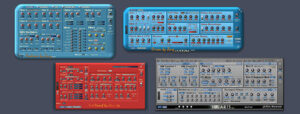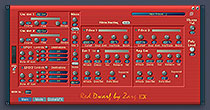The John Bowen Chronicles: Introduction
Dear Readers,
A little while after I started selling my first plug-ins for the SCOPE platform (in March 2000), I was asked by German Keyboards magazine if I would be interested in documenting my personal journey as a synthesizer guy via a monthly column (written in English by me and translated to German by Reinhard Schmitz, who was the Editor at the time, I believe). I told him I doubted that it would prove to be of interest to anyone, but he was insistent, and I agreed for a 6 month’s trial. I was sure it wouldn’t last more than that.
Well, I ended up being quite surprised, because when we were all done, 2 years had gone by! It seems there had been enough material for 24 issues, and we stopped the column at the point where I left Korg to work with this new German company and their SCOPE system. (A brief overview for those who didn’t get to read this series – I started out with Moog Music in 1973, then eventually became an integral part of the Sequential Circuits team, who went to Yamaha for a very brief stint before landing up at Korg, where I headed up the Wavestation series of products, and was involved with the original earlier version of the OASYS keyboard and PCI card.)
Now it seems the time has come to continue the story, as a number of ‘coincidences’ as viewed back then have turned into a bit of history for my forthcoming new keyboard, the Solaris. Sonic Core has invited me to talk about the events and developments over these last 8 years that have lead me to this point, and we will be posting over the next few months on a regular basis. I invite you all along for “the rest of the story”….

So, here we are, almost 9 years exactly since I started developing my first synth for SCOPE. I’ve been doing plug-ins for the SCOPE platform since early 2000, and this came about because 1 year after starting there, I had parted company with the organization who had developed the SCOPE system. Certainly, when I took a ‘leap of faith’ to leave a well-established Korg R&D group for this new unknown, I had no idea what was going to happen. My initial assignment, upon arriving in Siegburg, Germany, back in August 1998, was to develop a Modular synthesizer for a new product debuting in 3 weeks time – the Pulsar DSP card. Not only did I have to learn how to run the SCOPE SDK software quickly, but I had to learn what all the menus were for Windows – and in German! I had only worked with the Mac OS for all my time at Korg, and I had a bit of a struggle to figure out just how Windows 95 and 98 (which had just been introduced) actually worked!
I have to say, it’s to the credit of the SCOPE program that I was able to deliver a reasonable number of working modules for the first Pulsar/SCOPE Modular system in that 3 week time. It was fairly simple to learn, and having the results in real time, being able to test, try out, and hear things right away, was a tremendous advantage!

Following the feeling of success from that moment, after 7 weeks in Germany I returned home, but I think there was apprehension on both sides as to how things would work out at such a distance thereafter. There was a lack of direction and uncertainty, again on both sides, as to what I should do next. I suggested a model of a Prophet 5, but was met with apathy about that. I then suggested a version of the Prophet VS, and that got the go-ahead, but came to a quick stumbling block when I needed some new modules to be coded. The main DSP coder (Klaus Piehl) had to work on a reverb design, and so the Prophet VS was put aside for a short time. (Later, the design was carried out by another ex-Sequential teammate of mine, Matt Issacson, who had also joined the SCOPE developer group).
As 1999 progressed, it became clear that there were some problems ahead, and I eventually decided to quit in August. At that point, I had only delivered a couple of synth ideas: (1) a ‘lead’ synth, based a bit on my Prophet 5 experience; (2) a bass synth, which went on to become a plug-in called the SB-404; (3) an admittedly very large and complicated device based on a special SCOPE module called the ‘Rotor’; and (4) a small project based around a comb filter idea, which we had done for the OASYS PCI project while I was at Korg. The Rotor device was primarily to prove a concept, but was far from being practical. For the comb filter project, I had to request a new filter module from Klaus (which he delivered quite quickly). The ‘lead’ synth I felt was pretty good, but it was rejected, as was the Rotor, and Comb filter synth ideas…
